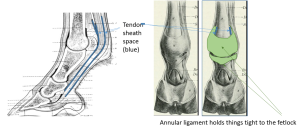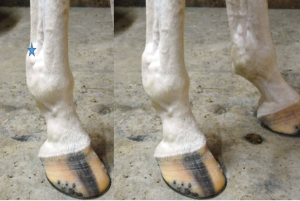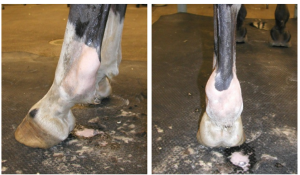Equine tendons and ligaments
Tendon sheaths and tenosynovitis
Tendons that traverse joints and have to alter direction during motion are often encased in a tendon sheath. A tendon sheath is a fibrous covering that envelopes the tendon. Within the sheath, the tendon is bathed in synovial fluid. Often, a ligamentous band holds the tendon and tendon sheath next to the joint. In the fetlock region, there are two such bands – proximal and distal annular ligaments.

As with other synovial structures, tendon sheaths can become inflamed or infected. Inflammation within a joint is referred to as synovitis, while inflammation within a tendon sheath is called tenosynovitis.
Tendon sheaths are very reactive and can become inflamed with tendonitis or nearby trauma as well as with direct trauma or infection. Inflammation leads to increased fluid production and thickening of the tendon sheath lining. Pain and heat can be observed in the acute stages but may be absent from chronic stages.
Management of tendon sheath infections is very similar to management of joint infections: lavage, anti-inflammatory agents and antibiotics. Antibiotics may be administered locally into the tendon sheath, via intravenous regional infusion and/or systemically. In the acute stages, lavage may be effectively performed using through and through needle lavage or arthroscopic lavage. Incisions into the tendon sheath may be required for chronic infections with fibrin proliferation within the sheath.
Windpuffs are common incidental findings on physical examination of the fetlock regions, particularly in the hindlimbs. This is the lay term for increased effusion in the digital flexor tendon sheath. Because of the annular ligament, the effusion is only noticeable above that band.

Fluid in the tendon sheath should be differentiated from fluid within the fetlock joint! The horse above may have both. The * is identifying fluid within the tendon sheath.
As mentioned, the annular ligament has an important role in maintaining the structural integrity of the fetlock joint region, despite extensive movement. It is possible for this structure to become traumatized and inflamed. The ligamentous inflammation (desmitis) can result in secondary inflammation and effusion within the tendon sheath. This can create much larger fluid filled “bulges”. Excessive effusion in the tendon sheath from primary inflammation or other cause of secondary inflammation can have a similar effect.

Unfortunately, the resulting pressure from the band and the excessive fluid can cause damage to the tendons and subsequent additional swelling. The treatment involves cutting the annular ligament to resolve the pressure.

